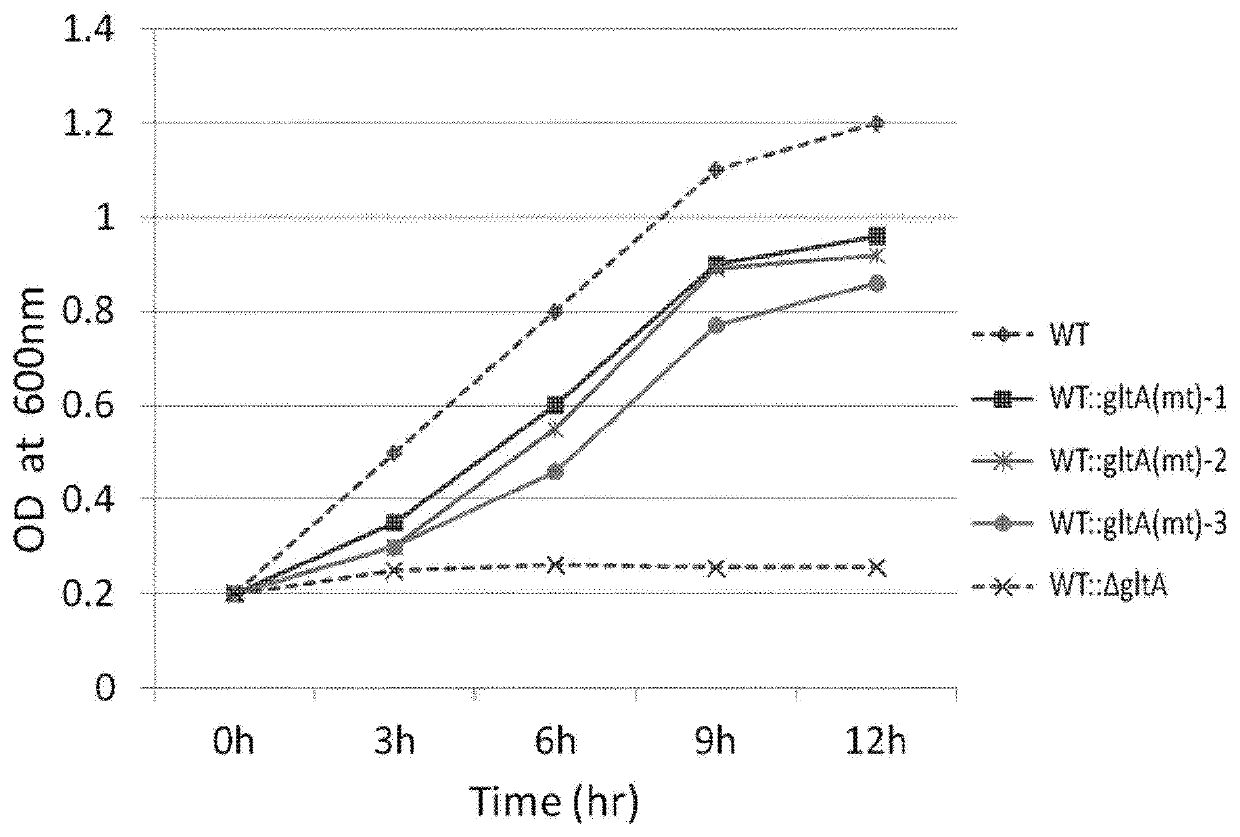Modified polypeptide with attenuated activity of citrate synthase and method for producing L-amino acid using the same
a technology of citrate synthase and modified polypeptide, which is applied in the direction of carbon-carbon lyases, lyases, transferases, etc., can solve the problems of low lysine production per unit time and significant reduction in sugar consumption rate, and achieve the effect of improving the amount of aspartate-derived l-amino acid production
- Summary
- Abstract
- Description
- Claims
- Application Information
AI Technical Summary
Benefits of technology
Problems solved by technology
Method used
Image
Examples
example 1
on of Vector Library for Introducing Modification in ORF of gltA Gene
[0064]For the purpose of discovering modified strains in which the expression level or activity of gltA gene of Corynebacterium glutamicum is attenuated, a library was prepared by the following method.
[0065]First, 0 to 4.5 modifications were introduced per 1 kb of a DNA fragment (1,814 bp) including the gltA gene (1,314 bp) using the GenemorphII Random Mutagenesis Kit (Stratagene). Error-prone PCR was performed using the chromosome of Corynebacterium glutamicum ATCC13032 (WT) as a template along with primers (SEQ ID NOS: 5 and 6) (Table 1). Specifically, the reaction solution containing the chromosome of the WT strain (500 ng), primers 5 and 6 (125 ng each), Mutazyme II reaction buffer (1×), dNTP mix (40 mM), and Mutazyme II DNA polymerase (2.5 U) was subjected to denaturation at 94° C. for 2 minutes followed by 25 cycles of denaturation at 94° C. for 1 minute, annealing at 56° C. for 1 minute, and polymerization a...
example 2
on of gltA-Deleted Strains and Screening of gltA-Modified Strains Based on Growth Rate
[0068]To prepare a strain of wild-type Corynebacterium glutamicum ATCC13032 in which the gltA gene is deleted, the pDZ-ΔgltA vector in which the gltA gene is deleted was prepared as follows. Specifically, the pDZ-ΔgltA vector (KR Patent No. 10-0924065) was prepared such that the DNA fragments (600 bp each) located at 5′ and 3′ of the gltA gene were ligated to the pDZ-ΔgltA vector. Primers (SEQ ID NOS: 7 and 8), in which a recognition site of the restriction enzyme (XbaI) was inserted at the 5′ fragment and the 3′ fragment, respectively, based on the nucleotide sequence of the reported gltA gene (SEQ ID NO: 2), and primers (SEQ ID NOS: 9 and 10), each located 600 bp apart from the primers (SEQ ID NOS: 7 and 8), were synthesized (Table 2). The 5′-end fragment was prepared by PCR using the chromosome of the Corynebacterium glutamicum ATCC13032 as a template along with primers (SEQ ID NOS: 7 and 9). Li...
example 3
ion of Nucleotide Sequences of Three gltA-Modified Strains
[0078]To confirm the nucleotide sequences of the gltA gene of the three selected strains (i.e., WT::gltA(mt)-1 to 3), the DNA fragments including the gltA gene in the chromosome were amplified using the primers (SEQ ID NOS: 5 and 6) specified in Example 1. PCR was performed as follows: denaturation at 94° C. for 2 minutes; 30 cycles of denaturation at 94° C. for 1 minute, annealing at 56° C. for 1 minute, and polymerization at 72° C. for 40 seconds; and polymerization at 72° C. for 10 minutes.
[0079]The nucleotide sequences of the amplified genes were analyzed, and as a result, it was confirmed that these nucleotide sequences commonly showed the introduction of 1 to 2 modifications into the nucleotide sequence located 721 bp to 723 bp downstream of the gltA gene ORF initiation codon. That is, it was confirmed that the WT::gltA(mt)-1 to 3 strains were modified strains of citrate synthase (CS) in which the 721st to the 723rd nuc...
PUM
| Property | Measurement | Unit |
|---|---|---|
| temperature | aaaaa | aaaaa |
| temperature | aaaaa | aaaaa |
| Tm | aaaaa | aaaaa |
Abstract
Description
Claims
Application Information
 Login to View More
Login to View More - R&D
- Intellectual Property
- Life Sciences
- Materials
- Tech Scout
- Unparalleled Data Quality
- Higher Quality Content
- 60% Fewer Hallucinations
Browse by: Latest US Patents, China's latest patents, Technical Efficacy Thesaurus, Application Domain, Technology Topic, Popular Technical Reports.
© 2025 PatSnap. All rights reserved.Legal|Privacy policy|Modern Slavery Act Transparency Statement|Sitemap|About US| Contact US: help@patsnap.com

